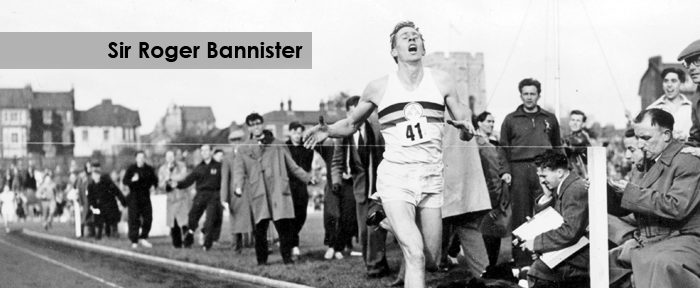Popular running culture tends to reflect the beliefs and priorities of the era that generates it.

Romancing Roger Bannister
Make up your mind. If you pass it up today you may never forgive yourself for the rest of your life.
This was coach Franz Stamphl’s compelling advice to a nervous Roger Bannister just before his record-setting run on May 6, 1954. Bannister was worried that the high winds buffeting the running track in Oxford that day would thwart his attempt at the first four-minute mile in history. But then, just 30 minutes before the race, the wind died down, suddenly making the Dream Mile seem possible. The idea at the heart of this passage ( that you must seize the right moment or risk its passing forever ) was very much a factor in Bannister’s record-setting run.
When I heard the sad news of Roger Bannister’s passing, I felt the world stop for just a moment. Perhaps it was similar to what people felt that night in May of 1954 when the official race clock stopped at 3:59.6. On Saturday, March 4th, after a long career as a neurologist, both in research and clinical practice, Bannister, who was knighted in 1975, died in Oxford. He was 88.
The Art & Science of the First Four Minutes
From the day that Roger Bannister made his debut in the mile with 4:53 in 1946, he gradually refined his training and toughened up his tall, slim body. Few amateur athletes had ever trained so systematically or scientifically. As an Oxford medical student, he had the luxury of spending almost unlimited time in the laboratory, where he would adjust the speed and gradient of a motor-driven treadmill to study his body’s reactions to high levels of exertion. With time and experimentation, he learned to simulate the stressors of the sub-four on the treadmill so he could study the changes in his body temperature, blood acidity and the composition of the air he was breathing and their effects on his body and mind.
The environment he was part of was rich in tradition. There were track facilities within walking distance and a system in place to produce Olympic champions. Day after day, week after week, he would merge his experience of himself on the treadmill with his experience of himself on the track. His primary focus was on gradually increasing the speed of his interval workout, which was 10 x 400-meter repeats (he would eventually reach 10 x 59 seconds). When he wasn’t running around in circles on the track he would skip class occasionally to train with his mates on nearby Harrow Hill, but only three times a week for 45 minutes (he may have actually been running more frequently, but only 28 miles per week).
As he once put it, Most top athletes will train two-three hours a day, whereas I would run half an hour “very hard” five days a week.
Looking back, Roger’s approach was extremely advanced for its day, a unique combination of researcher and athlete aiming at a world record. He was renowned for his unconventional training methods (a month before breaking the record he took a three-day break to go hiking). What I love most about him is that he ran very hard but never at the cost of relaxation. This way he didn’t overtrain but he also never undertrained. He always knew exactly what to expect of himself in terms of mental effort.
Bannister would later become a prominent neurologist, but be experienced the power of the mind first through running. He would often play post-war mind games like visualizing bombs and bullets raining down on him if he did not go at an absolute full tilt; he could be heard shouting “faster!” whenever he was full of energy or feeling fear – that mix of brimming self-confidence and lingering self-doubt that athletes experience in the heat of competition.
Fabulous Fifties
The fifties were an incredible period for pioneering feats of physical excellence, a time when the four-minute mile became a household phrase.
The official four-minute barrier had daunted runners for generations and was spoken of by some as an insurmountable barrier that was physiologically impossible. Roger had high hopes of breaking through it, with the eyes of the world watching, so that others might follow. And, with the help of his pacemakers, he did it… nicking under four minutes on a windy, rain-sodden evening on the Iffley Road Athletics Track – his long arms and legs churning, his head tilted slightly back, the storied performance that has transcended sports and will always lift my heart.
It’s very rare in any walk of life, at any time in history, that someone can claim they were the very first person to do something. Bannister’s unprecedented feat was considered an act of skill and endurance nearly as remarkable as reaching The North Pole or climbing Mount Everest. The world rejoiced in his success for generations to come. His name, like those of Babe Ruth, Bobby Jones, and Jesse Owens, became synonymous with singular athletic achievement.
Roger That!
The floodgate for the next wave super-milers was opened. His record-setting feat would be surpassed many times. Runners in the next decades would be faster, stronger, better-equipped, better-trained and able to devote much more of their time to their pursuit while benefiting from advances in sports science. But their later success did not dim the significance of Bannister’s run.
There have been thousands of sub-four minute miles inspired by Bannister’s dream run. In 1975, the 3:50 barrier was breached for the first time, by John Walker of New Zealand, and in 1999 Hicham El Guerrouj, a Moroccan, set the current world record of 3:43.13. The Russian Svetlana Masterkova holds the women’s record of 4:12.56.
Running has advanced so far that a four-minute-mile pace is actually not that fast anymore. Had they been in the same race, El Guerrouj would have beaten Bannister by more than 100 meters. Talented high schoolers run sub-four fairly routinely today.
If you’re reasonably athletic, I encourage you, too, to try running sub-4 pace for a few fleeting seconds in honor of the very first super-miler and one of the last gentleman athletes who has left us and whose legacy will endure forever.
Addendum
Bannister was, by nature, diligent and systematic. Franz Stamphl had a remarkable understanding of human nature and a highly infectious enthusiasm. After an earful from his trusted coach, Roger took the leap of faith that he could do something very special on the track that day even though, in his mind, he wasn’t sure the weather conditions would allow it.
If coaching can be defined as a blend of art and science, I put more emphasis on the art than most.
Running gives us a real-life experience of the scientific method as applied in our personal lives. While meticulous planning, scientific testing, and monitoring all have their place they can’t give us a complete picture of our true, innate running ability. By over-focusing on tangible physiological benchmarks, we often overlook the intangibles: the psychological, spiritual, and even mystical factors (all very much at play in Bannister’s record-setting run) that allow us to tap into our energies and unlock our hidden potential.
Acknowledgments
Running – a Global History, by Thor Gottas – A rich and engrossing resource for this post.



